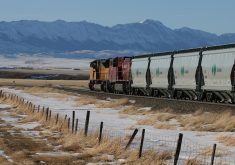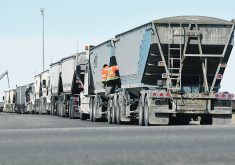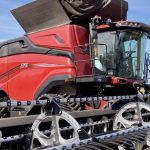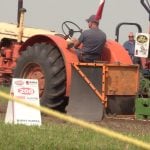Caterpillar’s new tandem truck might be entering a busy marketplace with intense competition, but there are differences that will separate it from the pack, says a company manager.
“This is not intended to be a highway hauler. We’re aiming it directly at the off-road market. To us, off-road means no road at all,” said Lorne Lagimodiere, truck manager at Toromont Cat in Winnipeg.
“It’s designed for muddy fields and construction sites. It’s the kind of ultra-heavy duty tandem customers would expect in a Caterpillar work truck.”
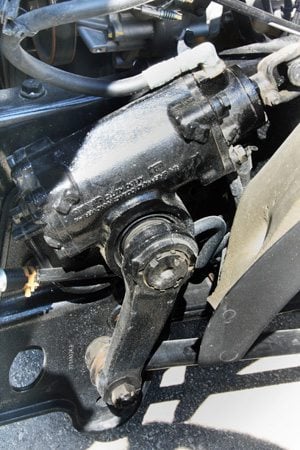
The Caterpillar CT660 was introduced earlier this year as a heavy duty Class Eight alternative to the many tandem trucks available.
Lagimodiere said water-logged fields are a major expense for farmers at harvest and many farmers have had more than their fair share.
“Guys take out clutches, transmissions, differentials. They twist the frames. Knock the axles out of alignment. There’s always a lot of busted-up equipment in a wet fall. That costs farmers real money, plus the downtime.”
He said when farmers are forced to pull a stuck tandem out of the mud, they sometimes inflict damage to the truck.
Cat engineers designed the CT660 truck with the idea that it would get stuck and yanked out a dozen times a day, every day.
Read Also

Alberta researcher helps unlock the economics of farming
Lethbridge Polytechnic researcher helping agriculture producers with decision-making tools in economic feasibility
“We want the truck to be yanked out with force every time without damage. We want the truck to take the shock and abuse with no twisted frames, axles knocked out of alignment or broken parts.
The front of the truck features a Mega Bracket as standard equipment. It can take the impact of 120,000 pounds combined weight with no damage to the truck.”
While the standard pair of hooks takes 120,000 lb. of force, the optional centre tow pin is rated at 150,000 lb.
The standard frame rails on the CT660 are 0.25 inch thick and 12 inches deep to prevent frame twist.
“Frame rails like that are an extra-cost option on other trucks. We designed the whole truck like that.”
He added that if the standard frame still isn’t stiff enough, CT660 can be ordered with double thickness rails. An outer C-channel fits over the standard C-channel, creating a frame rail that’s half an inch thick.
As well, dual steering boxes are standard equipment. The left front and the right front tire are each controlled by its own power steering box, which is synchronized to the other.
“…Any driver who has driven a dual-steering box truck in rough conditions will say that he won’t go back to the conventional single box. Your control is so much better with dual boxes.”
Another feature with the steering system is the setback of the front axle. With the tires positioned further back on the frame, the truck has a tighter turning radius.
To save weight, the CT660 engine block is made of compacted graphite iron, making it the lightest 13 litre engine on the market.
The outer halves of the front fenders are flexible rubber composite material, making them less susceptible to damage and easier to replace if they take a severe hit. The fenders slope down following the top curve of the tire, thus giving the operator the best possible forward visibility.
The front bumper, another item that typically sees a lot of damage, is made in three pieces. Like the rubber fenders, it’s easy for the customer to replace it himself without tying the truck up at a dealership.
Maximum frame length is 272 inches, making it suitable for a 20 foot grain box. The truck weighs between 18,000 and 19,000 lb. without a box. A driven front axle is available for customers who would rather drive out of the mud than be yanked out of it.
The truck is available with the CT11 and CT13 engines. The CT15 is expected to be available later this year. The engines use twin turbochargers with interstage cooling.
The CT11 is rated at 330 to 390 horsepower. The CT13 is 410 to 475 hp. The CT15 is 450 to 550 hp.
Lagimodiere said the smaller engines are a partnership that includes Caterpillar and Navistar. It is certified Tier 4, making it legal to sell for the remainder of 2012. However it is not Tier 4 compliant.
“Certified Tier 4 and compliant Tier 4 are two different things. Certified means you’re allowed to sell it, even if it doesn’t meet the criteria. Compliant means it actually does meet the criteria.”
The transmission is the CX31, which Cat has been installing in highway tractors since 2006. It has six forward speeds and one reverse gear. There’s a variety of axle choices from Meritor, Dana and Fabco.
Lagimodiere said the CT660 carries a premium price compared to a Kenworth T800, but when the cost of standard features in the CT660, which are extra options in the T800, are factored in, the prices are similar.
For more information, contact Lorne Lagimodiere at 204-478-6561 or visit www.cat.com/truck/CT660.





